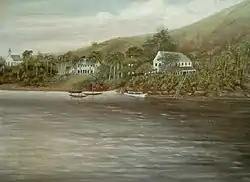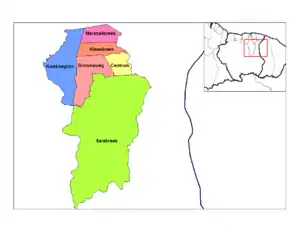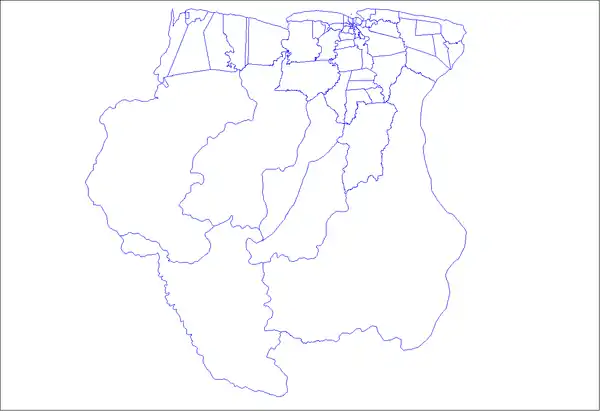Klaaskreek
Klaaskreek is a resort in Suriname, located in the Brokopondo District. Its population at the 2012 census was 2,124.[1] Located northeast of Brokopondo, the main town is Reinsdorp. In 2007, a technical training centre in biological agriculture was established at Klaaskreek to teach locals about enhancing agriculture in the area.[2]
Klaaskreek | |
|---|---|
 Berg en Dal (1885) | |
 Map showing the resorts of Brokopondo District. Klaaskreek | |
| Coordinates: 5°12′N 55°4′W | |
| Country | |
| District | Brokopondo District |
| Area | |
| • Total | 349 km2 (135 sq mi) |
| Population (2012)[1] | |
| • Total | 2,124 |
| • Density | 6.1/km2 (16/sq mi) |
| Time zone | UTC-3 (AST) |
History
Around 1860 an expedition lead by J. Rosenberg set out to discover gold. Even though some gold was discovered near Victoria, the government decided not pursue the matter. Rosenberg however persisted, established the New-York and Surinam Company, and finally received a concession in 1870. The company failed it meet its objectives, and the concession was nullified in 1874.[3]
Klaaskreek is situated in the proximity of the Brokopondo Reservoir. In 1958 Klaaskreek was designated as one of the transmigration towns for the inhabitants of the area that was flooded after the construction of the Afobaka Dam.[4] Klaaskreek is a tribal[4] area mainly inhabited by Maroons.[1]
Klaaskreek has a school, police station,[4] civil engineering company.,[5] river resort,[6] and a beach called Benastrand.[7] Medische Zending operates a clinic in the town.[8]
Towns
Other villages in the resort include Kapasikélé, Njun Lombe, Mujékiki, and Reinsdorp.[4] In 1960, an agriculture pilot project was started in Brokobaka, Centrum.[9] The project lead to a palm oil plantation and factory in the former plantation of Victoria.[10] however the Surinamese Interior War and lethal yellowing resulted in the closure of the factory in 1996.[11]
_Album_met_tekeningen_van_Suriname%252C_p.10_(50)_(serietitel)%252C_RP-T-1994-281-10.jpg.webp)
Berg en Dal
Berg en Dal is a former wood plantation located near the Afobakaweg. Berg en Dal was founded in 1737.[12] After the abolition of slavery, the plantation started a period of decline, and was sold to the Moravian Church in 1870.[13] In 1968, the road to Paramaribo was constructed,[4] which triggered a migration to the city. The Surinamese Interior War finally resulted in a near abandonment of the village.[14] The Moravian Church started a joint venture with hotel Krasnapolsky in Paramaribo, and in 2008 the former plantation was transformed into the Berg en Dal Eco & Cultural Resort, a luxury holiday resort with 150 rooms for ecotourism.[13]
| Wikimedia Commons has media related to Berg en Dal, Suriname. |
References
- "Resorts in Suriname Census 2012" (PDF). Retrieved 15 May 2020.
- "United Nations Development Programme". Archived from the original on 2011-07-23. Retrieved 2010-01-26.
- "Encyclopaedie van Nederlandsch West-Indië - Page 312 - Goudindustrie" (PDF). Digital Library for Dutch Literature (in Dutch). 1916. Retrieved 15 May 2020.
- "Onderzoek Regionaal plan Bronsweg 2015-2040" (PDF). Planning Office Suriname (in Dutch). Retrieved 12 May 2020.
- "Surinaams dorpje baalt van 'smerig' bedrijf". Waterkant.net (in Dutch). Retrieved 15 May 2020.
- "New Babunhol River Resort". Trip Advisor. Retrieved 15 May 2020.
- "Klaaskreek". Surivision (in Dutch). Retrieved 15 May 2020.
- "Zorggebied". Medische Zending.sr (in Dutch). Retrieved 15 May 2020.
- "Distrikt Brokopondo". Suriname.nu (in Dutch). Retrieved 15 May 2020.
- "Plantages / P / Phedra". Suriname Plantages. Retrieved 15 May 2020.
- "Oliepalmproductie zou geen prioriteit moeten zijn". Dagblad Suriname (in Dutch). Retrieved 15 May 2020.
- "Plantage Berg en Dal". Suriname Plantage (in Dutch). Retrieved 15 May 2020.
- "Surinaamse Broedergemeente stapt in ecotoerisme". Reformatorisch Dagblad (in Dutch). Retrieved 15 May 2020.
- "25 februari branden in geschiedenis Suriname". Waterkant.net (in Dutch). Retrieved 15 May 2020.
